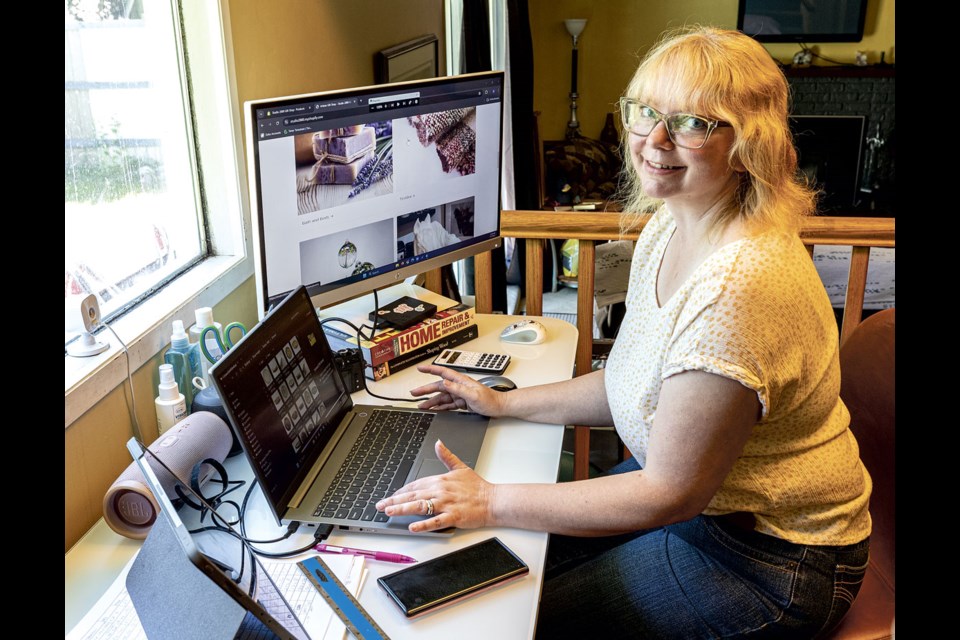She first noticed a change in her eyesight when she picked up her slick new camera and put her left eye to the viewfinder.
“I couldn’t see anything – it was just white and I thought my camera was broken,” Christina Watts, prominent Prince George artist, said.
Once she realized what was actually wrong, she wished it was only the camera that was broken.
“I looked at my husband and covered one eye and he disappeared,” Watts said. “And I thought 'uh-oh.'”
Watts, a painter, videographer, photographer and Community Arts Council of Prince George & District feature gallery/gift shop co-ordinator, was first diagnosed with wet macular degeneration in her left eye earlier this year.
After the initial diagnosis Watts was offered more details of her condition and she has a subset to the wet macular degeneration, called central serous retinopathy with choroidal neovascularization.
“It’s the same thing but it means that it shouldn’t affect the other eye any time soon, which is a relief,” Watts explained.
To prevent further deterioration of her eyesight, Watts is in the B.C. Retina Disease Treatment Program which was put into jeopardy earlier this year when there was a dispute between the Provincial Health Authority and the specialists who administered the eyesight-saving treatment. Luckily, everything has been worked out and treatments for everyone in need went uninterrupted.
Watts needs an injection of medicine into her eyeball. It started out once a month and now she is in a maintenance program so treatments are every seven weeks now.
“Since I’ve continued with the injections it’s actually improved my eyesight,” Watts said.
“I had a solid gray mass in the centre of my vision and the injections blasted it apart. Now I have a ton of floaties and I have this warped area.”
She can once again see colour out of her left eye so that’s a positive.
As Watts gets older there is a threat of glaucoma that would require corrective surgery but that is a future threat. There is always the chance that everything goes wrong with her left eye but Watts said that’s something to worry about another day.
With continued treatment the deterioration of her eyesight has been held at bay and the worst circumstance Watts finds herself in now is low-light settings with a lot of people present.
“I found myself waving at someone that wasn’t Sue, and I was like 'uh-oh,'” Watts said. “It’s mostly about facial recognition.”
She is quickly learning out how cope with her new circumstance and has adapted to it.
“Because you can sit on the couch, cry and just hide away from the world but that’s not going to get you anywhere,” Watts said. “So you learn new things and use the tools available to you.”
And access the services available like occupational therapy for those who have experienced vision loss.
Her biggest challenge is contrast.
“Everything else I can get around,” Watts said.
Chopping garlic on her white cutting board doesn’t happen anymore.
“I would lose sight of the garlic,” Watts said. “It all just blended together. So now I have colourful cutting boards.”
When Watts went to the independent living specialist she was given another useful tip.
“I kept slopping the toothpaste all over the sink,” Watts laughed. “Trying to get the white toothpaste on the white-bristled toothbrush was impossible. Things that are small and close up are problematic.”
The independent living specialist said to get her own tube of toothpaste and squirt it into her mouth and start brushing from there.
“Which is brilliant! Now I just have to remember which toothpaste is mine,” Watts said with a cheeky smile.
One of the best tools when a person has issues with eyesight is a cellphone, she added.
“The vision loss people helped me rig up all my devices,” Watts added.
She uses apps on her phone that offer options to have high contrast colours and magnifying capabilities to read the labels on most items and all the lights in Watts’ home are all warm, soft lights, no blue lights for her.
She moved her desk in front of the biggest window in her house.
“Making all those changes helps a lot,” Watts said.
When things like this happen, people are forced to take a beat and reevaluate priorities, and one of the things that Watts did sooner than later was take a bucket-list trip with her family.
“We kept saying we’ll wait, we’ll wait and then all of a sudden you stop waiting to do things and you start doing them,” Watts said.
So the family spent two weeks in Italy in the springtime and it was pretty perfect.
There’s still a lot to take in, there’s doubts and fears and other people’s perception on her circumstances.
“My biggest fear when I first told people was that they would just think I couldn’t do anything because I couldn’t see but I can still do everything I used to but now I have had to adapt and change and I am getting better at managing – I am faster and more efficient now,” Watts said.
“The most important thing for people to know is that even if your vision is limited you can still do a lot of the same things. I think that’s the key – it’s just about finding a different way of doing things. At first I thought I would just have to end everything but you can’t just end everything, you have to keep going. Curling up in a ball in the corner does nothing for anybody. You can have a good cry but then you have to pick yourself up and carry on.”



